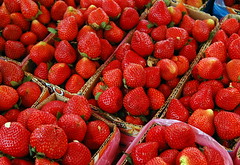It’s been a wet Spring up here in the mountains. We’ve been lucky to get some of the pop up showers in the last couple of weeks and haven’t had to water the garden. With so much rain the flowers have been delightful. The Spring Ephemerals bloomed in mass quantities for us.
Strawberries bloomed in full the first week of May, but the fruit didn’t set. We only got 3 tiny berries this year from our plants. Don’t know if it was too much rain or the coolness, but other folks around us didn’t have a crop either. We were lucky that an Amish fellow’s field didn’t fail and we got to eat lots of strawberries anyway. The strawberry season was very short, about a week-long this year, so we felt lucky to get a flat.
Now, if you know that a flat is 8 quarts, that’s a lot of berries. Upon getting the strawberries in the house, we promptly ate the first quart right then and there! Since we had enough sugar and a box of pectin in the cupboard, we made a batch of freezer jam. Each batch makes about 5 cups of jam per quart. In total we made three batches of freezer jam. We like to share with friends, so when somebody comes to visit they might just take home a treat. The rest of the berries were eaten fresh in the next three days, so you could say we liked them a lot.
